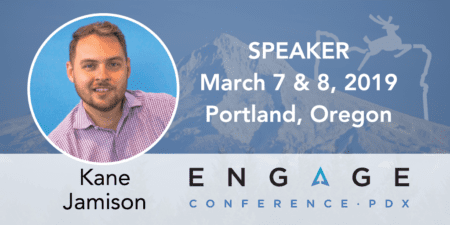 Kane Jamison will be speaking on Content Marketing at Engage which will take place March 7–8 in Portland Oregon. For more information or to purchase tickets, please click here.
Kane Jamison will be speaking on Content Marketing at Engage which will take place March 7–8 in Portland Oregon. For more information or to purchase tickets, please click here.
1) Please give us your background and let us know what you do for a living.
I’m the founder of Content Harmony, a content marketing agency based in Seattle. We work with eCommerce, software, and consumer brands to build content marketing programs that are heavily driven by results from SEO, PR, and paid social media.
2) What sort of content works best on paid platforms like Outbrain & LinkedIn?
I typically don’t recommend using generic display advertising solutions for content marketing efforts for most businesses – the exception being broadly used consumer goods like insurance, housewares, etc (hence why that one auto insurance startup has been following you around the internet the past few years). Your editorial content is inherently somewhat top of funnel and meant to drive brand awareness, but if you’re going to pay to promote it then that budget should primarily be used to reach your ideal audience. The problem with content distribution options like Outbrain or Taboola is that your targeting options are fairly limited when compared with social media advertising.
However, since these display networks have released retargeting solutions over the past few years, that’s where I see the most value for content marketers in display. My default recommendation to any business looking to get more value from their content programs is that retargeting based upon user interests from your blog/editorial content is the biggest opportunity to combine paid media with content marketing and move visitors down the funnel faster.
Paid social is an entirely different opportunity in my experience. Targeting options on Facebook and Linkedin, in particular, are so granular, even with recent target options being removed in 2018, that you can actually build ROI positive campaigns solely from promoting top of funnel content. My favorite example is a set of long-form, data-driven trend reports we did that were targeted by state, (imagine “2018 Home Buying Trends in Oregon” as an example). We did medium-sized campaigns in each of these states, around $2,000, to a few hundred thousand people who fit the general audience requirements for that business. The high-level numbers were 20-50,000 sessions per campaign, around 5-8 contacts generated, and 0-2 conversions per campaign. However, since those conversions had a short-term value around $5-10k, those campaigns generally paid for the content and the media spend, leaving the client with long-form pieces of content that had strong SEO potential and could easily be updated at a lower cost annually, while re-running those campaigns. If you can break even on content marketing within 30 days of hitting publish while knowing that there is a good amount of organic traffic still to come, it makes it very easy to continue investing in content marketing for the long term.
3) Can you share a few key elements of content that work well for both SEO & conversions?
The above campaign is a good example of this – the primary content value is passive link acquisition from people linking to statistics and trends, and organic traffic growth of an audience that can be successfully retargeted. But with enough volume at a low CPC (some of those clicks were 5-25 cents on Facebook) and a high enough customer lifetime value, it’s possible to drive a lot of brand awareness and a few conversions and have the effort pay off.
The other examples I like most are content pieces that connect the company’s product/solution with the higher level problem people are looking to solve, which can take a user from brand awareness to conversion rapidly in the right setting. The first example I usually think of is Sumo.com – they’ll take an article title like “How To Build An Email List From Scratch (4 Simple Steps)“, deliver on the promise of content that’s valuable, and manage to show off their product throughout the process. With enough promotion, it has a chance at ranking for a phrase like “how to build an email list”, so the social & SEO success elements are both there.
A similar example outside of marketing or software is probably easiest to find on a retailer’s site, since it’s easy for them to be (A) a source of reliable information and (B) remain somewhat unbiased about their brands since they typically carry a number of manufacturers and aren’t as in-your-face about their own products. With an example like “Laundry Room Refresh With Peel & Stick Backsplash Wall Tile” on the Home Depot blog, you’ll see photos of the project actually in progress, which makes the content more valuable for both SEO and social performance, and deep links directly to the product pages which is going to help distribute link equity from these DIY tutorials and send users directly to a product page (where they can be retargeted – brings it all full circle to that stuff up above). If you look around at long-tail phrases like “bathroom peel and stick wall tile diy”, that’s the type of content that will both rank and lead users to the product/solution they need to accomplish the project, so within 10-30 minutes you could reasonably see a homeowner go from a project research phase to ordering 100 square feet of tile for pickup at their local store so that they have it ready for their Saturday project.
Go to Kane’s Session on the Agenda
Todd Mintz knows PPC…knows Social Media…knows SEO…knows Blogging…knows Domaining…and knows them all real well. He runs growth marketing for )and is also a Director & Founding Member of SEMpdx: Portland, Oregon’s Search Engine Marketing Association, and he can be found here on Twitter and Facebook.
